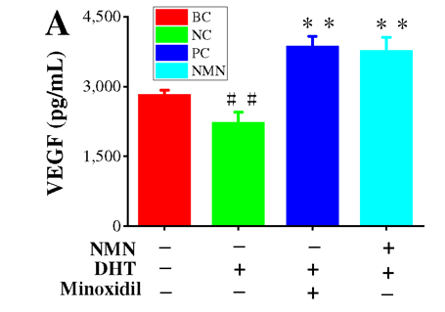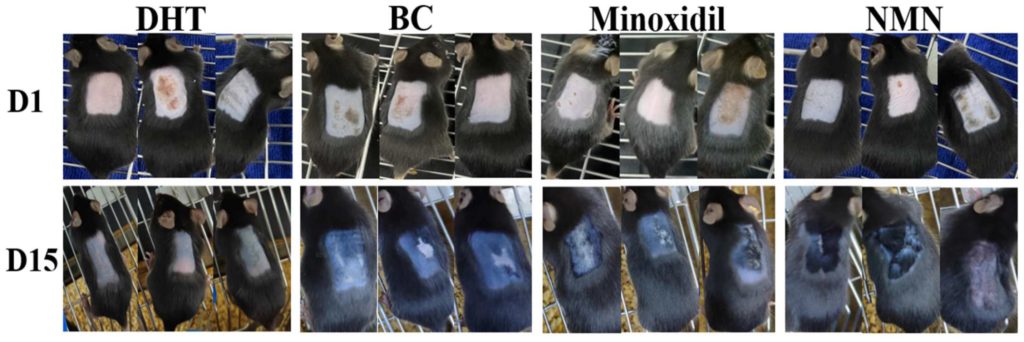Is NMN the New Rogaine?
Scientists show that NMN may promote hair growth by altering human hair stem cells, whereas the effect of NMN on hair growth in mice is not too convincing.
Highlights:
- In the cells responsible for generating new hair, NMN may promote hair growth by contributing to blood vessel formation and reducing inflammation.
- The effect of NMN on fur regrowth in mice is similar to that of no treatment at all.
Researchers from Guangxi University in China report in Molecules that NMN promotes hair growth. This was shown in human hair-regenerating cells exposed to DHT (dihydrotestosterone), a key hormone associated with baldness in humans. The DHT-exposed cells mimicked aspects of what occurs with hair loss and displayed reduced levels of a protein associated with forming new blood vessels called VEGF.
Reduced VEGF suggests reduced blood flow, a key contributor to hair loss. Indeed, the popular hair regrowth treatment minoxidil, which goes under the brand name Rogaine, promotes hair growth by increasing blood flow to hair follicles. Remarkably, NMN was shown to prevent VEGF losses just as well as Rogaine. Thus, NMN could potentially promote hair growth by encouraging blood flow.

(Xu et al., 2024 | Molecules) The blank control (BC) shows normal levels of VEGF in human hair follicle stem cells. Adding DHT, a negative control (NC), reduces VEGF protein levels. However, the further addition of NMN (NMN) or minoxidil, a positive control (PC), prevents DHT-induced decreases in VEGF.
In addition to preventing VEGF reductions, NMN was shown to prevent elevations in proteins associated with inflammation. Bearing in mind that hair follicle inflammation contributes to hampered hair growth, these results point to NMN promoting hair growth by reducing inflammation. Based on these results from human hair-regenerating cells, NMN would appear to promote hair growth. However, the Guangxi University researcher’s results from mice are not as convincing.
NMN Promotes Hair Growth?
The researchers assessed NMN’s effect on hair growth in mice by removing their fur and watching it regrow in response to topical application of 0.5% NMN.

Fur regrowth was also measured in response to 5% minoxidil (Rogaine) and both NMN- and minoxidil-treated mice displayed similar levels of fur regrowth after 15 days. Still, this regrowth was comparable to mice not treated with anything, suggesting that neither NMN nor minoxidil significantly improves normal fur regrowth in mice.
In contrast, a fourth group of mice showed much less fur regrowth than the NMN-treated, minoxidil-treated, and non-treated mice. These mice were injected with DHT, making them a good model for age-related hair loss. However, it seems this model was underutilized, considering that if all four groups of mice had been injected with DHT, the results may have revealed whether NMN or minoxidil could potentially counteract age-related hair loss.
How to Science
In the abstract for the current study, the authors wrote,
“The effects of NMN on the growth of mouse hair were observed after hair removal. The results indicated that NMN can reverse the state of hair follicle atrophy, hair thinning, and hair sparsity induced by dihydrotestosterone (DHT), compared to that of minoxidil.”
However, this is misleading because mice treated with NMN or minoxidil were not exposed to DHT. Furthermore, NMN and minoxidil treatment led to similar changes to no treatment, suggesting NMN and minoxidil had no significant effect. Overall, it is unclear whether NMN counteracts the anti-hair growth effects of DHT in mice. This ambiguity is reflected more fairly in the conclusion of the study, where the authors say,
“The administration of NMN at a specific concentration in the NMN groups stimulated hair growth during the growth phase, similar to the effects observed in the control and blank groups. The effects of NMN were comparable to those of minoxidil.”
Model: C57BL/6 mice
Dosage: 0.5% topical NMN

